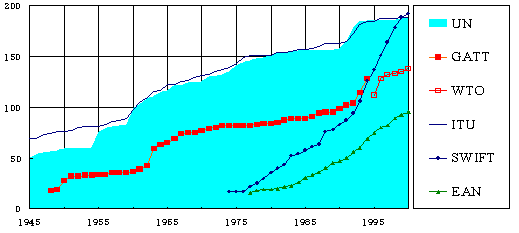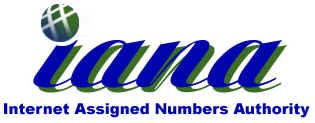ICT Policy Initiatives in Asia-Pacific
Yoshiki Mikami
Professor, Management and Information Systems Engineering
Nagaoka University of Technology
e-mail: mikami@kjs.nagaokaut.ac.jp
URL: http://kjs.nagaokaut.ac.jp/mikami/
|
|
|
|
|
|
|
|
|
|
|
|
|
|
|
|
|
|
|
|
|
|
|
|
|
|
|
|
|
|
| Source of Flag Images: The Ministry of Foreign Affairs of Japan. Flags shown above represent those countries which my past audience at both NUT campus and CICC came from, and it does not mean that this lecture covers all of those countries. |
INDEX
1. Telecom Infrastructure Overview
Improvement in telecom infrastructure has been drastically accelerated during last ten years. It took forty years before Japan's teledensity grew from 1 to 10 (1928-1968). Teledensity of China, however, reached 1 in 1992, and reached 10 in 2000. This can be explained partly by progress of technology and partly by changes in telecom industry structure. Although government monopolies were the common scenes in most countries in Asia-Pacific region at the beginning of 1990s, those public monopolies almost disappeared from the scene in the late 1990s.
Main Telephone Lines per 100 inhabitants
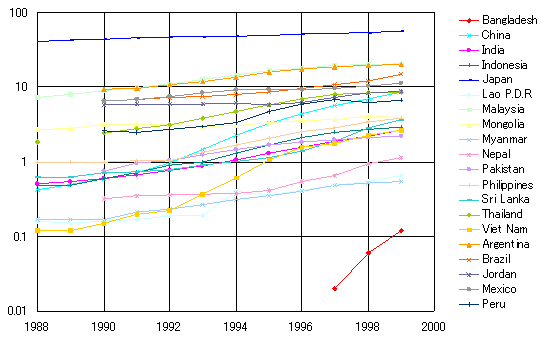
[Source] International Telecommnication Union, Yearbook of Statisitics.
Cellular Subscribers per 100 inhabitants
[Source] International Telecommnication Union, Yearbook of Statisitics.
Growth of the Internet has been far more faster than any other media in the history of communications. And time-lags of benchmark years between countries become much shorter than in the days of telegram and telephone.
Growth of the Internet (Number of Hosts)
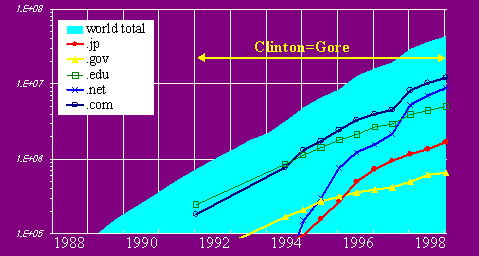
[Source] Internet Software Consortium (http://www.isc.org/)
Q.1 Compare benchmark years in telecommunication infrastructure development. And realize how your country's improvement has been accelerated. Check EXCEL data and fill blanks below.
| Country | service started | over 1 | over 10 | ||
|
Teledensity = Number of fixed telephone lines per 100 population |
USA | [a] | 1876 | 1899 | 1914 |
| Japan | [b] | 1889 | 1928 | 1968 | |
| Your country | [c] | ||||
| lag with USA | [c]-[a] | ||||
| lag with Japan | [c]-[b] | ||||
|
Number of mobile subscribers per 100 population |
USA | [d] | - | 1988 | 1995 |
| Japan | [e] | - | 1991 | 1996 | |
| Your country | [f] | ||||
| lag with USA | [f]-[d] | ||||
| lag with Japan | [f]-[e] | ||||
|
Number of internet hosts per 100 population |
USA | [g] | - | 1994 | 1998 |
| Japan | [h] | - | 1998 | not yet | |
| Your country | [i] | ||||
| lag with USA | [i]-[g] | ||||
| lag with Japan | [i]-[h] |
Q.2 Describe your country's telecommunication service operators today.
| Basic telephone service | Mobile service | ISPs | |
| government or private | |||
| monopoly or not | |||
| short list of companies | |
Table ICT Policy Initiatives Timeline
|
|
Asia |
Other World |
|
1980s |
Japan, NTT's FTTH Plan ( -2025) |
|
|
1990 |
|
|
|
1991 |
|
Al Gore's NII |
|
1992 |
Singapore, IT2000 |
|
|
1993 |
China, Three Gold Plan |
|
|
1994 |
Philippines, NITP2000 |
Uruguay Round negotiation finalaized |
|
1995 |
Korea, NII Plan Malaysia, Multimedia Super Corridor Vietnam, NITP |
Netscape IPO; Dot Com Big Bang |
|
1996 |
Thailand, IT2000 |
US, Telecommunication Act revised |
|
1997 |
Indonesia, Nusantara 21 Philippines, IT21 |
Information Technology Agreement |
|
1998 |
Hong Kong, Digital 21 |
|
|
1999 |
Korea, Cyber Korea 21 |
|
|
2000 |
Singapore, Infocomm 21 |
Dot Com Bubble burst |
|
2001 |
Thailand, e-Thailand |
|
Globalization of Business Transaction Networks
Global business networks require their own language, consisting of communication protocols, message format/syntax, vocabulary, various codes, etc, in addition to physical connection. Growth of membership to SWIFT, EAN International and ITU illustrate globalization of these connections.
SWIFT: Society for Worldwide Interbank Financial Telecommunication
EAN International: Article number Registration authority
ITU: International Telecommunication Union
Figure Growth of Membership to SWIFT, EAN Int'l and ITU
source
United Nations WTO ITU SWIFT EAN International
Success Stories & Best Practices in Asia-Pacific
India's Software Industry
NASSCOM: National Association of Software and Services Companies
http://www.nasscom.org/Alibaba.com, China
http://www.alibaba.com
"The global trend of importing directly from Chinese manufacturers rather than through trading companies from Taiwan and HK is inevitable as Chinese factories are gaining trading skills and experiences through the help of companies like Alibaba." by Annie Jie Xu, Alibaba.com Business Alliance Manager on May 16, 2002 in Los Angeles (Trade and the Internet - Sourcing Opportunities in Asia)AEOMA EC Best Practices (Asia Oceania Electronic Marketplace Association )
http://www.aoema.org/EC-Best-Practice/index.htmReadiness Assessment
APEC EC Steering Group has developed "EC Readiness Assessment Guide", which proposes a set of check points to assess country's readiness for doing business electronically. (see http://www.gipiproject.org/readiness/ )
Basic Infrastructure and Technology
Access to Necessary Services
Current Level and Type of Use of the Internet
Promotion and Facilitation Activities
Skills and Human Resources
Positioning for the Digital Economy (Environment for E-Commerce)
Government Policies
Cyber Laws (see 5. below)
Awareness Promotion
Assistance to SMEs
Portal
Table EC Resource Centers in Asia
Singapore
EC Singapore
Thailand
EC Resource Center (ECRC)
Malaysia
EC Hub
Japan
ECom
Hong Kong
Korea
China
Standard Development Organizations (SDOs) and Consortium
ITU, UN/CEFACT, ISO/IEC/JTC1 are working in the area of standardization of information and telecommunication technologies.
The internet related standard development and management.
Also various type of industry-lead consortia are working to develop application specific standards.
Membership status of selected countries to the above organizations.
http://kjs.nagaokaut.ac.jp/mikami/e-gov/stds-consortium/frame.htm
4. e-Government
e-Government initiatives were launched in several countries. It is expected to play key role in promoting
better governance / quality service
efficient government
catalyze e-commerce
Existing ONE-STOP website of Asian government are ...
country
ONE STOP Government site
serving since
Singapore
eCitizen Centre
http://www.ecitizen.gov.sgApril 1999
Hong Kong
ESDlife
http://www.esdlife.com or http://www.esd.gov.hkDec 2000
Taiwan
http://www.gov.tw/
Chinese Only1999
e-Governments under planning are ...
|
Philippines |
Government
Information System Plan (GISP) |
announced |
|
India |
Electronic
Governance Homepage |
|
|
|
|
|
World
e-Government Links
http://www.egovlinks.com/world_egov_links.html
United Nations Online Network in Public
Administration and Finance (UNPAN) E-government Portal
http://www.unpan.org/egovernment.asp
5. Digital Signature & Public Key Infrastructure
Digital Signature Laws
|
country |
Title of Act |
legislated |
go
into force |
|
Malaysia |
1997 |
1998/10/01 |
|
|
Singapore |
1998/07/10 |
1998/7/10 |
|
|
Korea |
Electronic Commerce and Electronic Signature Act |
1999/02/ |
1999/07/ |
|
Hong Kong |
2000/01/05 |
2000/02/18 |
|
|
Japan |
Law on Digital Signature and Certification Procedure |
2000/05/31 |
2001/04/01 |
|
Philippines |
2000/06/14 |
? |
|
|
Thailand |
Electronic Transactions Act |
2001? |
2001? |
|
Indonesia |
Drafting |
? |
? |
Certification authorities (CAs)
|
Country |
Controller of CAs |
Authorized Certification Authorities (CAs) |
|
Malaysia |
Digicert ( POS Malaysia & MIMOS JV) |
|
|
Singapore |
CCA |
|
|
Hong Kong |
|
Hongkong POST e-Cert |
|
Korea |
|
KICA |
Japan PKI Forum
http://www.japanpkiforum.jp/E/index.htm
6. e-School & Human Resource Development
e-School
country
e-School project
Thailand
School Net Thailand
http://www.school.net.th/Japan
7. ICT Manpower: Status, Certificates, Mutual Accreditation
|
Country |
Certification Scheme, Matching Scheme, etc. |
|
India |
DOEACC: Department of Electronics Scheme on ICT professional quality assurance. http://www.doeacc.org.in/ |
|
Japan |
Japan
Information Technology Engineers Examination Centre (JITEC). |
|
Malaysia |
|
| Singapore | Certified IT Project Manager (CITPM): managed by Singapore Computer Society (SCS) and endorsed by NICC |
| Thailand |
SEARCC/SRIG on
Professional Standards (SRIG-PS)
Report on the Regional ICT Manpower and Skills Survey 1999-2000
The report reveals profile (age, gender, educational background,
annual remuneration, technical competency, etc.) of ICT manpower in
eight countries in the region; India, Indonesia, Japan, Pakistan,
Philippines, Singapore, Sri Lanka and Thailand.
SEARCC/SRIG on Certification (SRIG-CERT)
The group is seeking for mutual accreditation of ICT professional certificates among member societies. Current members are
-
Singapore (SCS)
-
Hong Kong (HKCS)
-
Australia (ACS)
-
New Zealand (NZCS)
Bilateral Mutual Recognition Schemes on ICT Professionals
-
Japan-Singapore: Media Release (2001/08/24)
-
Japan-India:
-
Japan-China:
-
Japan-Korea:
Cross-boarder Flow of ICT engineers
-
US: The huge absorber: H1-B Visa policy
8. Free Software, Open Source Initiatives
Use of free software is spreading in developing countries
Software and Service Industry Demand - Supply (1998, US M$)

[Source] JISA, NASSCOM, International Data Corporation
Hardware Industry Demand - Supply (1998, US M$)
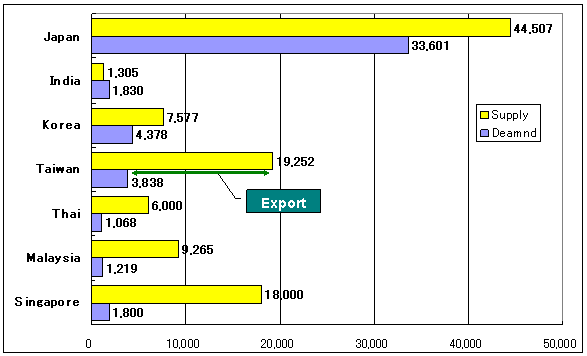
[Source] JISA, NASSCOM, International Data Corporation
|
Country |
Project |
|
India |
|
|
Thailand |
|
|
Malaysia |
|
|
Major Elements |
|
Local Industry Computerization
-
Singapore's Local Enterprise Computerization Programme
The Local Enterprise Computerisation Programme (LECP) aims to encourage small and medium-sized enterprises (SMEs) to achieve a higher level of competitiveness through a more effective use of information technology (IT). For more details, see iDA site ( http://www.ida.gov.sg/ )
-
WTO
-
Information Technology Agreement
Global Digital Divide
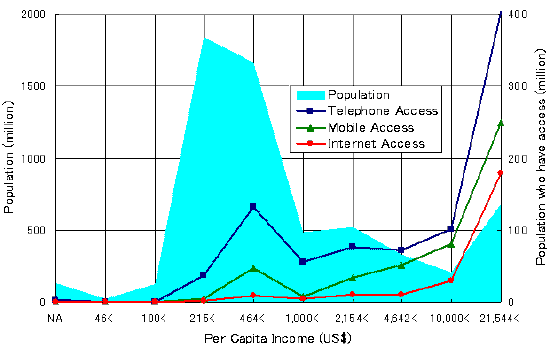
For more details >> See Mikami's UNU Presentation
Related Links
Digital Opportunity Task Force
http://www.dotforce.org/UNESCO Institute of Statistics (UIS) for literacy, education data
http://www.uis.unesco.org/Divide among Languages and Scripts
Universal Declaration of Human Rights
http://www.unhchr.ch/udhr/navigate/alpha.htm
The Declaration is translated into more than 330 languages of the World. Most of non-Latin texts, however are presented by image files, not by encoded texts.Multilingual Computing Resources
http://mlcr.nagaokaut.ac.jp/main/
e-ASEAN Task Force
http://www.e-aseantf.org/APEC Telecommunication & Information Working Group
http://www.apectel.org/apec/main.htmlPan Asian EC Alliance
Tradelink Electronic Commerce Limited (Hong Kong)
Singapore Network Services Pte Ltd (SNS) (Singapore)
Korea Trade Network (KTNet) (Korea)
Inforshare Information Technology Development Co. Ltd.(IITD) (China)
|
|
 |
||
| ASEAN e-Task Force | APEC |
Thailand Malaysia Singapore Philippines Indonesia ITECC China Korea Taiwan Mongolia Hong Kong SAR Vietnam Laos Cambodia Myanmar Brunei India Pakistan Sri Lanka Nepal Bangladesh MIT Argentina Brazil Mexico Peru Jordan
last updated 2002/07/01 © Yoshiki Mikami 2001 mail to Yoshiki Mikami

